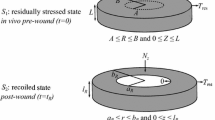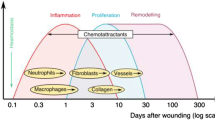Abstract
Angiogenesis consists of the growth of new blood vessels from the pre-existing vasculature. This phenomenon takes place in several biological processes, including wound healing. In this work, we present a mathematical model of angiogenesis applied to skin wound healing. The developed model includes biological (capillaries and fibroblasts), chemical (oxygen and angiogenic growth factor concentrations) and mechanical factors (cell traction forces and extracellular matrix deformation) that influence the evolution of the healing process. A novelty from previous works, apart from the coupling of angiogenesis and wound contraction, is the more realistic modelling of skin as a hyperelastic material. Large deformations are addressed using an updated Lagrangian approach. The coupled non-linear model is solved with the finite element method, and the process is studied over two wound geometries (circular and elliptical) of the same area. The results indicate that the elliptical wound vascularizes two days earlier than the circular wound but that they experience a similar contraction level, reducing its size by 25 %.
Similar content being viewed by others
References
Anderson A, Chaplain M (1998) Continuous and discrete mathematical models of tumor-induced angiogenesis RID A-5355-2010. Bull Math Biol 60: 857–899. doi:10.1006/bulm.1998.0042
Carmeliet P, Jain R (2000) Angiogenesis in cancer and other diseases. Nature 407: 249–257. doi:10.1038/35025220
Chaplain M (2000) Mathematical modelling of angiogenesis RID A-5355-2010. J Neurooncol 50: 37–51. doi:10.1023/A:1006446020377
Cheung J, Zhang M, Leung A, Fan Y (2005) Three-dimensional finite element analysis of the foot during standing - a material sensitivity study RID F-8331-2011. J Biomech 38: 1045–1054. doi:10.1016/j.jbiomech.2004.05.035
Delalleau A, Josse G, Lagarde J-, Zahouani H, Bergheau J- (2008) A nonlinear elastic behavior to identify the mechanical parameters of human skin in vivo. Skin Res Technol 14: 152–164. doi:10.1111/j.1600-0846.2007.00269.x
Flegg JA, McElwain DLS, Byrne HM, Turner IW (2009) A three species model to simulate application of hyperbaric oxygen therapy to chronic wounds. PLoS Comput Biol 5: e1000451. doi:10.1371/journal.pcbi.1000451
Flegg JA, Byrne HM, McElwain LS (2010) Mathematical model of hyperbaric oxygen therapy applied to chronic diabetic wounds. Bull Math Biol 72: 1867–1891. doi:10.1007/s11538-010-9514-7
Flynn C, Taberner A, Nielsen P (2011) Modeling the mechanical response of in vivo human skin under a rich set of deformations. Ann Biomed Eng 39: 1935–1946. doi:10.1007/s10439-011-0292-7
Geris L, Schugart R, Van Oosterwyck H (2010) In silico design of treatment strategies in wound healing and bone fracture healing. Philos Trans R Soc A Math Phys Eng Sci 368: 2683–2706. doi:10.1098/rsta.2010.0056
Glazier J, Graner F (1993) Simulation of the differential adhesion driven rearrangement of biological cells. Phys Rev E 47: 2128–2154. doi:10.1103/PhysRevE.47.2128
Gros J, Farinelli W, Sadow P, Anderson R, Bruns R (1995) On the mechanism of skin wound contraction—a granulation-tissue knockout with a normal phenotype. Proc Natl Acad Sci USA 92: 5982–5986. doi:10.1073/pnas.92.13.5982
Gurtner GC, Werner S, Barrandon Y, Longaker MT (2008) Wound repair and regeneration. Nature 453: 314–321. doi:10.1038/nature07039
Hendriks F, Brokken D, van Eemeren J, Oomens C, Baaijens F, Horsten J (2003) A numerical-experimental method to characterize the non-linear mechanical behaviour of human skin. Skin Res Technol 9: 274–283. doi:10.1034/j.1600-0846.2003.00019.x
Hibbit D, Karlson B, Sorensen P (2011) Theory manual, version 6.9. HKS inc. Pawtucket
Holzapfel GA (2000) Nonlinear solid mechanics: a continuum approach for engineering. Wiley, Chichester, pp 295–304
Hughes TJR (1987) The finite element method: linear static and dynamic finite element analysis. Prentice Hall International, Englewood Cliffs
Javierre E, Vermolen FJ, Vuik C, van der Zwaag S (2008) Numerical modelling of epidermal wound healing. Springer, Berlin; Heidelberger Platz 3, D-14197 Berlin, Germany
Javierre E, Moreo P, Doblaré M, García-Aznar JM (2009) Numerical modeling of a mechano-chemical theory for wound contraction analysis RID F-8256-2010. Int J Solids Struct 46: 3597–3606. doi:10.1016/j.ijsolstr.2009.06.010
Lapeer RJ, Gasson PD, Karri V (2011) A hyperelastic finite-element model of human skin for interactive real-time surgical simulation. IEEE Trans Biomed Eng 58: 1013–1022. doi:10.1109/TBME.2009.2038364
Linder-Ganz E, Shabshin N, Itzchak Y, Yizhar Z, Siev-Ner I, Gefen A (2008) Strains and stresses in sub-dermal tissues of the buttocks are greater in paraplegics than in healthy during sitting. J Biomech 41: 567–580. doi:10.1016/j.jbiomech.2007.10.011
Maggelakis S (2003) A mathematical model of tissue replacement during epidermal wound healing. Appl Math Model 27: 189–196. doi:10.1016/S0307-904X(02)00100-2
Manoussaki D (2003) A mechanochemical model of angiogenesis and vasculogenesis. ESAIM-Math Model Numer Anal Model Math Anal Numer 37: 581–599. doi:10.1051/m2an:2003046
Mantzaris N, Webb S, Othmer H (2004) Mathematical modeling of tumor-induced angiogenesis. J Math Biol 49: 111–187. doi:10.1007/s00285-003-0262-2
McGrath M, Simon R (1983) Wound geometry and the kinetics of wound contraction. Plast Reconstr Surg 72: 66–72
Moreo P, Garcia-Aznar JM, Doblare M (2008) Modeling mechanosensing and its effect on the migration and proliferation of adherent cells RID F-8256-2010. Acta Biomater 4: 613–621. doi:10.1016/j.actbio.2007.10.014
Murphy K, Hall C, Maini P, McCue S, McElwain D (2012) A fibrocontractive mechanochemical model of dermal wound closure incorporating realistic growth factor kinetics. Bull Math Biol 74(5): 1–28. doi:10.1007/s11538-011-9712-y
Murray J, Cook J, Tyson R, Lubkin S (1998) Spatial pattern formation in biology: I. Dermal wound healing. II. Bacterial patterns RID F-8802-2011. J Frankl Inst Eng Appl Math 335: 303–332. doi:10.1016/S0016
Olsen L, Sherratt J, Maini P (1995) A mechanochemical model for adult dermal wound contraction and the permanence of the contracted tissue displacement profile. J Theor Biol 177: 113–128. doi:10.1006/jtbi.1995.0230
Olsen L, Sherratt J, Maini P (1996) A mathematical model for fibro-proliferative wound healing disorders. Bull Math Biol 58: 787–808. doi:10.1007/BF02459482
Pettet G, Byrne H, Mcelwain D, Norbury J (1996a) A model of wound-healing angiogenesis in soft tissue. Math Biosci 136: 35–63. doi:10.1016/0025-5564(96)00044-2
Pettet G, Chaplain M, McElwain D, Byrne H (1996b) On the role of angiogenesis in wound healing RID A-5355-2010. Proc R Soc Lond Ser B Biol Sci 263: 1487–1493. doi:10.1098/rspb.1996.0217
Risau W (1997) Mechanisms of angiogenesis. Nature 386: 671–674
Roy S, Biswas S, Khanna S, Gordillo G, Bergdall V, Green J, Marsh CB, Gould LJ, Sen CK (2009) Characterization of a preclinical model of chronic ischemic wound. Physiol Genomics 37: 211–224. doi:10.1152/physiolgenomics.90362.2008
Schreml S, Szeimies RM, Prantl L, Karrer S, Landthaler M, Babilas P (2010) Oxygen in acute and chronic wound healing. Br J Dermatol 163: 257–268. doi:10.1111/j.1365-2133.2010.09804.x
Schugart RC, Friedman A, Zhao R, Sen CK (2008) Wound angiogenesis as a function of tissue oxygen tension: a mathematical model. Proc Natl Acad Sci USA 105: 2628–2633. doi:10.1073/pnas.0711642105
Singer A, Clark R (1999) Mechanisms of disease—cutaneous wound healing. N Engl J Med 341: 738–746
Tranquillo R, Murray J (1992) Continuum model of fibroblast-driven wound contraction—inflammation-mediation. J Theor Biol 158: 135–172. doi:10.1016/S0022-5193(05)80715-5
Williams PL, Warwick R (1980) Gray’s anatomy. Churchill Livingstone, Edinburgh
Xue C, Friedman A, Sen CK (2009) A mathematical model of ischemic cutaneous wounds. Proc Natl Acad Sci USA 106: 16782–16787. doi:10.1073/pnas.0909115106
Zienkiewicz OC, Taylor RL (2000) The finite element method. Butterworth Heinemann, Oxford
Author information
Authors and Affiliations
Corresponding author
Rights and permissions
About this article
Cite this article
Valero, C., Javierre, E., García-Aznar, J.M. et al. Numerical modelling of the angiogenesis process in wound contraction. Biomech Model Mechanobiol 12, 349–360 (2013). https://doi.org/10.1007/s10237-012-0403-x
Received:
Accepted:
Published:
Issue Date:
DOI: https://doi.org/10.1007/s10237-012-0403-x




